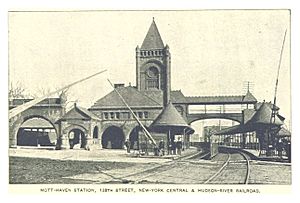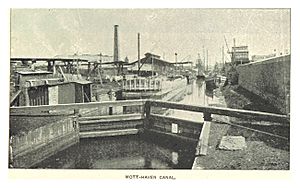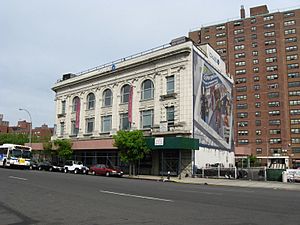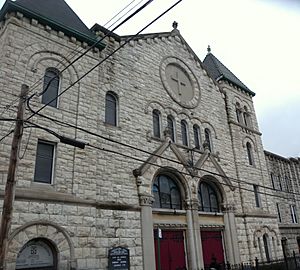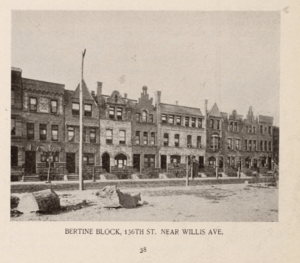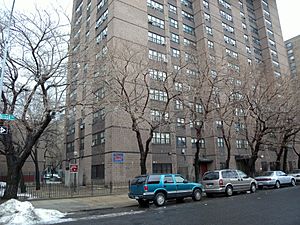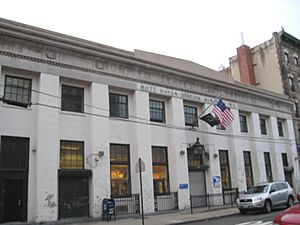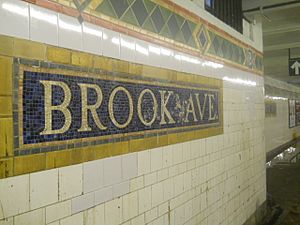Mott Haven, Bronx facts for kids
Quick facts for kids
Mott Haven
|
|
|---|---|
|
Neighborhood of the Bronx
|
|
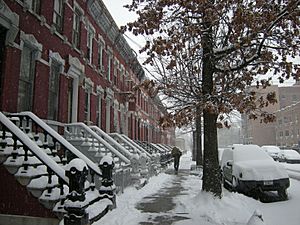
East 139th Street, between Willis and Brook Avenues, facing east
|
|
| Nickname(s):
"The Boogie Down Bronx"
|
|
| Country | |
| State | |
| City | |
| Borough | |
| Community District | Bronx 1 |
| Founded | 1849 |
| Named for | Jordan Lawrence Mott |
| Area | |
| • Total | 3.06 km2 (1.180 sq mi) |
| Population
(2020)
|
|
| • Total | 54,163 |
| • Density | 17,722/km2 (45,901/sq mi) |
| Economics | |
| • Median income | $25,325 |
| Ethnicity | |
| • Hispanic | 68.8% |
| • Black | 28% |
| • White | 1.9% |
| • Asian | 0.4% |
| • Other | 0.9% |
| ZIP Codes |
10451, 10454, 10455
|
| Area codes | 718, 347, 929, and 917 |
| Website | |
|
Mott Haven Historic District
|
|
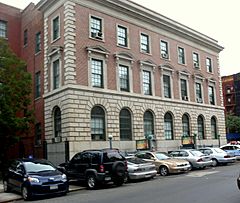
40th Precinct Police Station, July 2010
|
|
| Location | An irregular pattern along Alexander Ave. and E. 138th St., New York, New York |
| Area | 11 acres (4.5 ha) |
| Built | 1850 |
| Architect | Multiple |
| Architectural style | Gothic, Queen Anne, Romanesque |
| NRHP reference No. | 80002586 |
| Added to NRHP | March 25, 1980 |
Mott Haven is a neighborhood in the southwestern part of the Bronx, a borough of New York City. It's mostly a place where people live. The area is generally bordered by East 149th Street to the north, the Bruckner Expressway to the east and south, and the Harlem River to the west. East 138th Street is a main road that runs through Mott Haven.
This neighborhood is part of Bronx Community Board 1. It uses ZIP Codes 10451, 10454, and 10455. The New York City Police Department's 40th Precinct helps keep Mott Haven safe.
Contents
Getting Around Mott Haven
Mott Haven has many ways to get around. The local subway line is the IRT Pelham Line (6 <6> trains), which runs along East 138th Street. There are also several local buses, including the Bx1, Bx2, Bx17, Bx19, Bx21, Bx32, Bx33, M125.
You can also reach Mott Haven by crossing several bridges from other parts of New York City. These include the Triborough Bridge, the Third Avenue Bridge, the Madison Avenue Bridge, the 145th Street Bridge, and the Willis Avenue Bridge. If you're traveling by train, the closest Metro-North Railroad stops are Harlem – 125th Street and Yankees – East 153rd Street.
Mott Haven's Story
How Mott Haven Began
The Bronx is named after a Swedish sea captain named Jonas Bronck. In 1639, a Dutch company bought the land that is now Mott Haven from the Wecquaesgeek people, who were part of the Lenape tribe. Bronck built his farm, called "Emmanus," near what is now Willis Avenue and 132nd Street. A peace treaty between the Dutch and the Wecquaesgeek chiefs was even signed at Bronck's house! This important moment is shown in a painting by American artist John Ward Dunsmore.
Even though Bronck only lived there for four years, the land became known as "Broncksland." The river next to his land also kept the name Bronck's River. The name "Bronx land" was first written down in 1697.
Growing into a Neighborhood
The area we call Mott Haven was sold to the Morris family in 1670. Later, in 1849, Jordan Lawrence Mott bought a small part of this land for his iron works. You can still see a small part of the old iron works near the Third Avenue Bridge on East 134th Street. St. Ann's Church on St. Ann's Avenue is a very old church where important members of the Morris family are buried. It's also a Registered Historic Place.
As New York City grew, Mott Haven quickly became a residential area. Fancy brownstone homes were built along Alexander Avenue in the 1890s. This area was even called "Doctors' Row" or "Irish Fifth Avenue." Soon after, the Bronx grew even faster, especially with new public transportation like the Third Avenue Elevated Line. By the early 1900s, many apartment buildings were built to house the growing population.
From the late 1800s to the 1940s, Mott Haven was home to many different groups of people. There were German-American families, Irish-American families, and an Italian community. Later, in the late 1940s, Puerto Rican families began to settle along Brook Avenue. African-Americans also moved into the area when the Patterson Houses were built.
The "South Bronx" Era
Mott Haven and Port Morris were the first neighborhoods to be called the "South Bronx." Before that, they were known as the North Side or North New York. These areas became part of New York City in 1898. The Chase Manhattan Bank building at Third Avenue and East 137th Street was originally the North Side Board of Trade Building, built in 1912.
In the 1940s, some social workers noticed a small area of poverty in Mott Haven and called it the South Bronx. Over time, this area faced challenges, and some housing projects were built. During the 1960s, many buildings in the area were damaged or destroyed.
Later, people tried to give Mott Haven new nicknames like the "Piano District" and the South Bronx as "SoBro," but these names didn't really stick.
Modern Redevelopment
Today, Mott Haven is seeing a lot of new building projects, especially along East 138th Street. There are new luxury apartments and also new affordable housing complexes. Mott Haven also has a community program that supports local farming. Future plans include more affordable rental buildings and even a Hampton Inn hotel.
People of Mott Haven
Mott Haven is a busy neighborhood with many people living close together. Most people rent their homes here. The neighborhood is mainly made up of Puerto Rican families, along with African Americans, Mexicans, and Dominicans.
In 2010, the population of Mott Haven and Port Morris was about 52,413 people. This was a small increase from the year 2000. The neighborhood covers about one square mile.
Most people living in Mott Haven are young people and middle-aged adults. About 28% are under 18, and another 28% are between 25 and 44 years old.
Mott Haven's Land and Landmarks
Mott Haven has many apartment buildings and large public housing complexes. There are also three special historical areas with brownstone rowhouses. In recent years, more modern homes have been built, allowing more people to own their homes. Mott Haven has many New York City Housing Authority (NYCHA) projects, which are public housing developments. The land in Mott Haven is mostly flat, except around St. Mary's Park, where it's a bit hilly.
Historical Districts and Important Places
Mott Haven has three Historic Districts: Mott Haven, Mott Haven East, and the Bertine Block. These areas are protected because of their historical importance and unique architecture.
- The Mott Haven Historic District is on Alexander Avenue between East 138th and East 141st Streets. It has many four- and five-story row houses built in the late 1800s. This district includes "Doctors' Row" and "Irish Fifth Avenue." You can also find the 40th Precinct police station, the Mott Haven Branch of the New York Public Library (built in 1905), and Saint Jerome's Roman Catholic Church here. It was added to the National Register of Historic Places in 1980.
- The Mott Haven East Historic District is on East 139th and East 140th Streets between Brook and Willis Avenues. It features rows of brownstones designed in the 1880s with Dutch and Flemish styles on one side and Greek-inspired styles on the other.
- The Bertine Block Historic District is on East 136th Street between Brook and Willis Avenues. This district has yellow-brick brownstones designed between 1891 and 1895.
St. Ann's Episcopal Church is on St. Ann's Avenue. It's the oldest church in the Bronx, built in 1841. Important historical figures like Lewis Morris, who signed the Declaration of Independence, are buried there.
Public Housing in Mott Haven
Mott Haven is home to seventeen New York City Housing Authority (NYCHA) developments. These buildings show the different types of public housing built in New York City over many years. Some examples include:
- Dr. Ramon E. Betances I, II, III, IV, and V
- Millbrook Houses and Millbrook Extension
- Mitchel Houses
- Moore Houses
- Mott Haven Houses
- Patterson Houses
Local News and Safety
Media
The Mott Haven Herald is a news source that covers Mott Haven, Melrose, and Port Morris. It is created by students from the CUNY Graduate School of Journalism.
Fire Safety
Mott Haven has three New York City Fire Department (FDNY) fire stations to help keep residents safe:
- Squad 41 – 330 East 150th Street
- Engine Company 60/Ladder Company 17/Battalion 14 – 341 East 143rd Street
- Engine Company 83/Ladder Company 29 – 618 East 138th Street
Also, FDNY EMS Station 14 is located at Lincoln Hospital at 234 East 149th Street.
Post Offices and ZIP Codes
Mott Haven uses several ZIP Codes: 10451 (west of Third Avenue), 10455 (east of Third Avenue, north of 145th Street), and 10454 (south of 145th Street). The United States Postal Service has several post offices in Mott Haven:
- Bronx Station – 558 Grand Concourse
- Mott Haven Station – 517 East 139th Street
- Hub Station – 633 St. Ann's Avenue
- Uptown Parcel Annex Station – 845 East 136th Street
Education in Mott Haven
Mott Haven has many schools for students of all ages. In general, the neighborhood has a lower rate of college-educated residents compared to the rest of New York City. About 16% of adults aged 25 and older have a college degree or higher.
The percentage of elementary school students in Mott Haven and Melrose who are good at math has increased. However, reading skills have stayed about the same. It's also important to note that more elementary school students in Mott Haven and Melrose miss school often compared to the rest of New York City.
Schools in the Area
Public Schools:
- South Bronx Classical Charter School II
- P.S. 18 John Peter Zenger School
- P.S. 277 Dr. Evelina Lopez Antonetty
- P.S 25 Bilingual School
- P.S. 30 Wilton School
- P.S. 40 Mott Haven Village
- P.S. 43 Jonas Bronck School
- P.S. 49 Willis Avenue School
- P.S. 65 Mother Hale Academy
- I.S. 139 A. Burger Intermediate School
- I.S. 162 Lola Rodriguez de Tio
- M.S. 223: The Laboratory School of Finance and Technology
- P.S. 154 Johnathan D. Hyatt School
- I.S. 183 Paul Robeson School
- P.S. 754 School for Career Development/Foreign Language Academy of Global Studies
- P.S. 221 South Bronx Preparatory: A College Board School
- P.S. 369 Young Leaders Elementary School
- South Bronx Charter School for International Cultures and the Arts
- The Bronx Charter School for Children
- The Bronx Academy of Letters
- Bronx School for Law Government and Justice
- Health Opportunities High School
- Community School for Social Justice
- Family Life Academy Charter School II
- Dream Charter School (K-12 Campus)
- New York City Montessori Charter School
- Mott Haven Academy Charter School
- KIPP Academy Elementary School
- KIPP Academy Middle School
- Success Academy Bronx 1
- Eugenio María de Hostos Community College of The City University of New York (CUNY)
- Hostos Lincoln Academy
Private/Parochial Schools:
- Saint Luke School
- Saint Pius V School
- Saint Pius V High School
- St. Anselm's School
Mott Haven Library
The New York Public Library has a branch in Mott Haven at 321 East 140th Street. This library, which is a Carnegie library, first opened in 1905 and is considered a New York City designated landmark.
Transportation Hubs
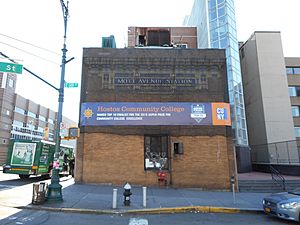
Here are the New York City Subway stations that serve Mott Haven:
- 138th Street–Grand Concourse (4 and 5 train)
- Third Avenue–138th Street (6 <6> trains)
- Brook Avenue (6 train)
- Cypress Avenue (6 train)
- East 143rd Street–St. Mary's Street (6 train)
- 149th Street–Grand Concourse (2 4 5 trains)
- Third Avenue–149th Street (2 5 trains)
The following MTA Regional Bus Operations bus routes also serve Mott Haven:
- Bx1: to Riverdale (via Grand Concourse)
- Bx2: to Kingsbridge Heights (via Grand Concourse)
- Bx4: to Westchester Square (via Westchester Avenue)
- Bx17: to Fordham Plaza (via Prospect and Crotona Avenues)
- Bx19: to Riverbank State Park or Bronx Park (via 149th Street and Southern Boulevard)
- Bx21: to Westchester Square – East Tremont Avenue (6 <6> trains) (via Boston Road and Morris Park Avenue)
- Bx32: to VA Hospital (via Morris Avenue and Jerome Avenue)
- Bx33: to Harlem or Port Morris, Bronx (via 138th Street)
- Bx41 (including Select Bus Service): to Williamsbridge (via Melrose and Webster Avenues)
- M125: to The Hub or Manhattanville (via Willis Avenue and 125th Street)
The 145th Street Bridge and Madison Avenue Bridge from Manhattan lead to Mott Haven. The Willis Avenue Bridge also connects to Mott Haven. The Triborough Bridge also ends in Mott Haven.
Famous People from Mott Haven
Many interesting people were born, grew up, or live in Mott Haven. Here are a few:
- A.G., a rapper, grew up in the Patterson Houses.
- Danny Aiello (1933–2019), an actor, lived on Bergen Avenue.
- Nate Archibald (born 1948), a former NBA basketball player, grew up in the Patterson Houses.
- Iran Barkley (born 1960), a former boxer, was raised in the Patterson Houses.
- Jonas Bronck (died 1643), the sea captain who gave the Bronx its name.
- Bobby Darin (1936–1973), a famous singer, lived at 629 East 135 Street.
- ESG, a band, are from the Moore Houses.
- Edward J. Flynn (1891–1953), a politician who led the Democratic National Committee.
- Kase2 (1958–2011), a graffiti artist, is from the Moore Houses.
- French Montana (born 1984), a rapper, is from the Mott Haven Houses.
- Percee P (born 1969), a rapper, grew up in the Patterson Houses.
- Johnny Pacheco (1935–2021), a musician who helped create "salsa" music.
- Luis Antonio Ramos (born 1973), an actor, is from the Patterson Houses.
- Prince Royce (born 1989), a singer, is from the Patterson Houses.
- José E. Serrano (born 1943), a United States Congressman, grew up in the Millbrook Houses.
- Rod Strickland (born 1966), an NBA basketball player, was raised in the Mitchel Houses.


